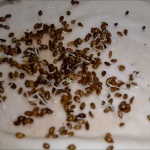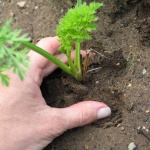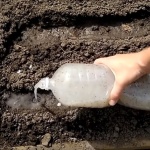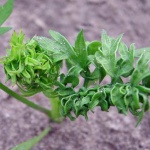
- Year of approval: 2006
- Appointment: for fresh consumption, for canning, for freezing, for bundled products, for making juice
- Leaf rosette shape: semi-spreading
- Leaves: long, green, medium dissected
- Weight, g: 200-260
- The form : cylindrical with blunt tip
- Taste qualities: excellent
- Composition : dry matter 11.6-16.8%, total sugar 6.5-9.6%, carotene up to 21.4 mg per 100 g of raw matter
- Ripening terms: late ripening
- Growing regions: TsCHO, Central, Far East
Berlicum Royal is a carrot variety approved for use in 2006. In Russia, this variety is grown in the Central Black Earth region, but in general this variety is able to adapt to any conditions, except for a short summer, since during this period the late-ripening tubers do not have time to ripen.
Description of the variety
These are tasty sweet carrots, which, moreover, can be stored for a long time even in winter and retains their marketability at the level of 75-95%. In general, the variety is unpretentious, but very sensitive to watering, but it has a high immunity to diseases.
Characteristics of the appearance of the plant and root crops
The rosette of leaves is semi-spreading, the leaves themselves are long, green, the root crop develops in the form of a cylinder with a blunt tip, its weight is about 200-260 grams, the length is 20-23 cm. The skin of the vegetable is smooth, orange, the core is also orange.
Purpose and taste of tubers
Carrots are characterized by juicy, crispy, sweet pulp. Inside contains a lot of useful substances that benefit the body if the product is not heat treated. In addition, the vegetable can be used for canning, freezing; this variety is also suitable for making carrot juice.
Maturation
Berlikum Royal belongs to varieties with a late ripening period, the crop can be harvested only 110-130 days after germination.
Yield
This is a high-yielding variety that can produce an average of 180-340 quintals of carrots per hectare. Cleaning usually takes place in the second half of September. The harvested crop must be sorted out, damaged tubers can be processed, and whole roots can be left in a well-ventilated area for a week to dry. Then they are stored in two layers in containers at a temperature of +6 degrees and a humidity of 70%.
Growing and care
Planting of carrots of the presented variety is carried out in late April or early May. Seeds are sown according to the scheme 5-7x15 cm, a distance of 15 cm is maintained between the rows. This variety will feel best in fertile light loamy or sandy loam soil with a high humus content. It is recommended to avoid clay soils. An area well lit by the sun is suitable for planting.
Pay special attention to watering. It is a moisture-loving variety that needs uninterrupted moisture supply. When watering, direct the stream into the aisles. To moisturize, use warm, settled water, and water itself in the evening.
At the stage of tuber formation, the frequency of irrigation should be reduced, but more water should be used. It is enough to water every 6-10 days and apply 20 liters of water per square meter. A couple of weeks before harvesting, humidification should be stopped altogether.
During the sprouting period, the first feeding can be made, at this time the nitrophoska solution will be appropriate.After 20 days, it is recommended to feed the vegetable with a solution of compost and wood ash. Keep in mind that at the stage of vegetative growth, fresh organic matter cannot be used - it is added for digging no later than six months before planting.
Another important point when caring for Berlikum is weed control. Loosening and removal of weeds should be carried out in the aisles a day after watering, deepen the tool no more than 5-8 cm.In the period when the frequency of watering decreases to once every 6-10 days, it is recommended to mulch the soil with compost - this procedure will ensure preservation moisture in the ground and will prevent weeds and pests.
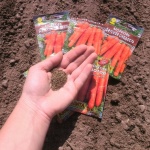
Carrots are one of the most unpretentious crops in terms of growing conditions; they can endure a short drought and a short cold snap. However, to get tasty and large root crops, you should adhere to the basic rules for planting carrots.
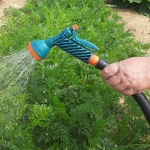

Disease and pest resistance
This variety is distinguished by high immunity to diseases and harmful insects, it is not prone to flowering, as well as to cracking of fruits, that is, additional processing with chemicals is not required.
However, in rare cases, if the watering regime is not followed, more precisely, when overflowing, the vegetable can be affected by various rot or powdery mildew. If this problem could not be avoided, then dig up the affected specimen, scatter wood ash with "Fundazol" in a 1: 1 ratio on the area next to the dug plant. During the illness and rehabilitation of plants, it is necessary to completely stop watering, and to a greater extent attend to loosening the soil.

Carrots grow in almost any garden. There is an opinion that this culture is very resistant to all kinds of diseases and pests, but this is not the case. Without proper care, carrots become susceptible to all kinds of infections and are affected by harmful insects.


